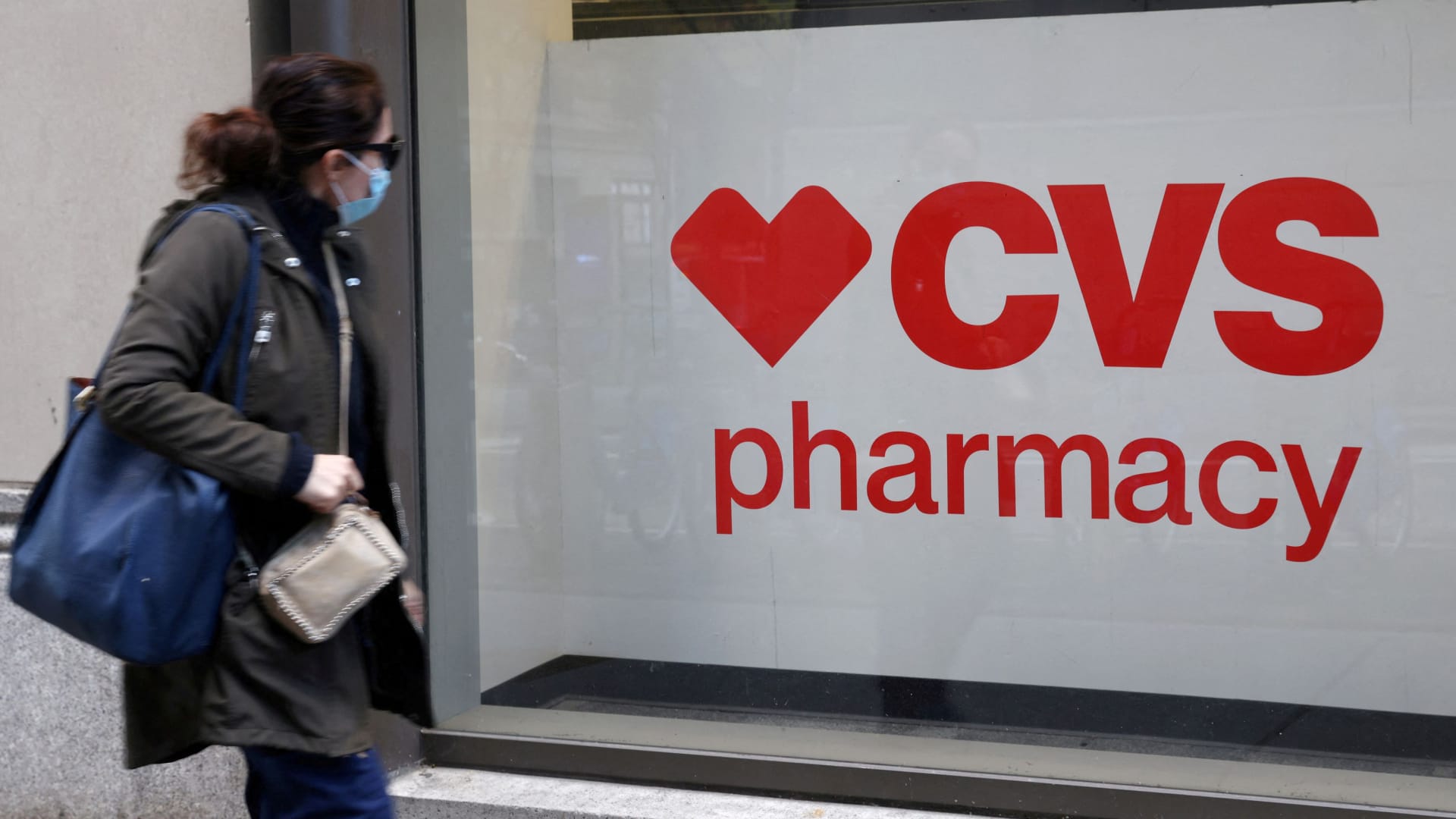
A person walks by a CVS Pharmacy store in Manhattan, New York, on Nov. 15, 2021.
Andrew Kelly | Reuters
CVS Health on Wednesday reported first-quarter revenue and adjusted earnings that missed expectations and slashed its full-year profit outlook, citing higher medical costs that are dogging the U.S. insurance industry.
Shares of the company dropped 10% in premarket trading.
The drugstore chain expects 2024 adjusted earnings of at least $7 per share, down from a previous guidance of at least $8.30 per share. Analysts surveyed by LSEG were expecting full-year adjusted profit of $8.28 per share.
CVS also cut its unadjusted earnings guidance to at least $5.64 per share, down from at least $7.06 per share.
The company said its new outlook assumes that higher medical costs in its insurance business during the first quarter will persist throughout the year. CVS owns health insurer Aetna.
Still, CVS CEO Karen Lynch said in a statement that the “the current environment does not diminish our opportunities, enthusiasm, or the long-term earnings power of our company.” CVS is confident “we have a pathway to address our near-term Medicare Advantage challenges,” she added.
Insurers such as Humana and UnitedHealth Group have seen medical costs spike as more Medicare Advantage patients return to hospitals for procedures they delayed during the pandemic, such as joint and hip replacements.
Medicare Advantage, a privately run health insurance plan contracted by Medicare, has long been a key source of growth and profits for the insurance industry. But investors have become more concerned about the runaway costs associated with those plans, which cover more than half of all Medicare beneficiaries.
Here’s what CVS reported for the first quarter compared with what Wall Street was expecting, based on a survey of analysts by LSEG:
- Earnings per share: $1.31 adjusted vs. $1.69 expected
- Revenue: $88.44 billion vs. $89.21 billion expected
CVS reported net income of $1.12 billion, or 88 cents per share, for the first quarter. That compares with net income of $2.14 billion, or $1.65 per share, for the same period a year ago.
Excluding certain items, such as amortization of intangible assets and capital losses, adjusted earnings per share were $1.31 for the quarter.
CVS booked sales of $88.44 billion for the quarter, up nearly 4% from the year-earlier period. That increase was driven by its pharmacy business and insurance unit.
Meanwhile, CVS said sales in its health services segment, which includes the pharmacy benefit manager Caremark, declined during the period. That was mainly due to the loss of a large unnamed client, the company noted.
In January, Tyson Foods said it had dropped CVS’ Caremark and instead chose PBM startup Rightway to manage drug benefits for its 140,000 employees starting this year. That came months after Blue Shield of California, one of the largest in the nation’s most populous state, also dropped Caremark and instead partnered with Amazon Pharmacy and Mark Cuban’s Cost Plus Drugs company.
Those decisions add to an upheaval in the health-care industry, as startups promising lower costs and transparency challenge the largest PBMs and pressure them to change their own business models.
The first-quarter results come as CVS pushes to transform from a major drugstore chain into a large health-care company. CVS deepened that push over the last year with its nearly $8 billion acquisition of health-care provider Signify Health and a $10.6 billion deal to buy Oak Street Health, which operates primary-care clinics for seniors.
Pressure on insurance unit
CVS’ health insurance segment generated $32.24 billion in revenue during the quarter, a more than 24% increase from the first quarter of 2023. The division includes plans by Aetna for the Affordable Care Act, Medicare Advantage and Medicaid, as well as dental and vision.
Sales blew past analysts’ estimate of $30.69 billion for the period, according to StreetAccount.
But the insurance division reported adjusted operating income of just $732 million for the first quarter. That is well below analysts’ expectation of $1.19 billion, according to FactSet.
The segment’s medical benefit ratio — a measure of total medical expenses paid relative to premiums collected — increased to 90.4% from 84.6% a year earlier. A lower ratio typically indicates that the company collected more in premiums than it paid out in benefits, resulting in higher profitability.
Analysts had expected that ratio to be 88.4%, according to FactSet estimates.
CVS said the rise was mainly driven by increased utilization of Medicare Advantage and the “unfavorable impact” of the company’s Medicare Advantage star ratings. Those ratings help Medicare patients compare the quality of Medicare health and drug plans.
CVS added that an additional day in 2024 due to the leap year also contributed to the higher medical benefit ratio.
Health services, pharmacy businesses miss
A workers stocks the shelves in a CVS pharmacy store on February 07, 2024 in Miami, Florida.
Joe Raedle | Getty Images
The company’s health services segment generated $40.29 billion in revenue for the quarter, a nearly 10% drop compared with the same quarter in 2023.
The division includes CVS Caremark, which negotiates drug discounts with manufacturers on behalf of insurance plans, along with health-care services delivered in medical clinics, through telehealth and at home.
Those sales were in line analysts’ estimate of $40.29 billion in revenue for the period, according to FactSet.
CVS said the decline was driven in part by the loss of the unnamed client and “continued pharmacy client price improvements.” The decrease was partially offset by growth in Oak Street Health, Signify Health and specialty pharmacy services, which help patients who are suffering from complex disorders and require specialized therapy.
The health services division processed 462.9 million pharmacy claims during the quarter, down from the 587.3 million during the year-ago period.
CVS’ pharmacy and consumer wellness division booked $28.73 billion in sales for the first quarter, up almost 3% from the same period a year earlier. That segment dispenses prescriptions in CVS’ more than 9,000 brick-and-mortar retail pharmacies and provides other pharmacy services, such as diagnostic testing and vaccination.
Analysts had expected the division to bring in $29.5 billion in sales, according to FactSet.
The company said the rise was primarily driven by heightened prescription volume, including increased contributions from vaccinations. Pharmacy reimbursement pressure, the launch of new generic drugs and decreased front-store volume, among other factors, weighed on the division’s sales.







